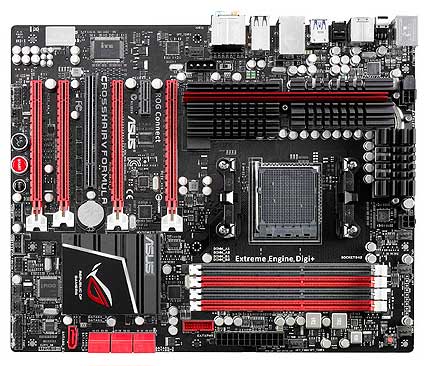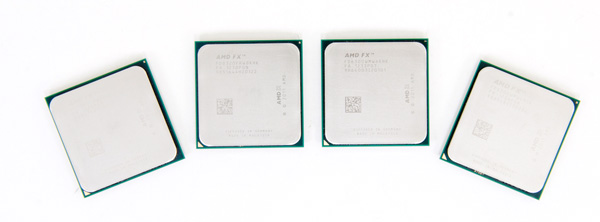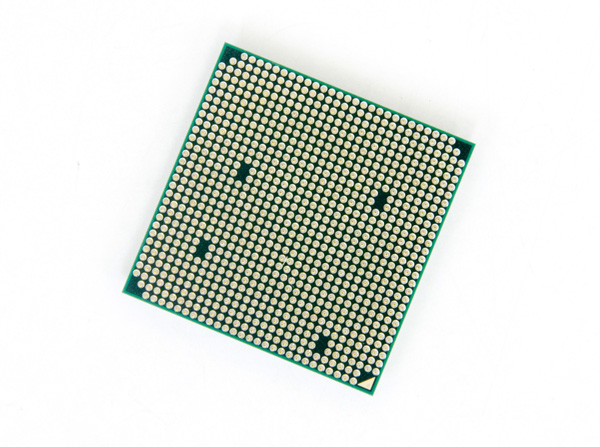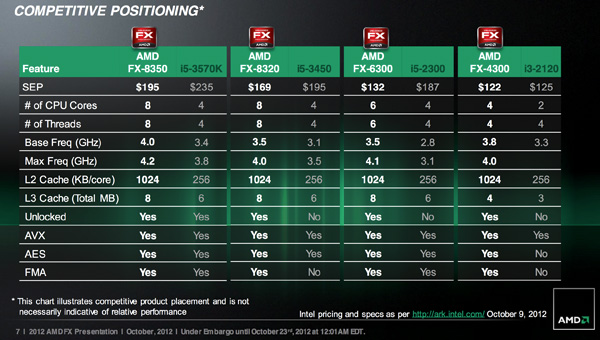The Vishera Review: AMD FX-8350, FX-8320, FX-6300 and FX-4300 Tested
by Anand Lal Shimpi on October 23, 2012 12:00 AM ESTLast year's launch of AMD's FX processors was honestly disappointing. The Bulldozer CPU cores that were bundled into each Zambezi chip were hardly power efficient and in many areas couldn't significantly outperform AMD's previous generation platform. Look beyond the direct AMD comparison and the situation looked even worse. In our conclusion to last year's FX-8150 review I wrote the following:
"Single threaded performance is my biggest concern, and compared to Sandy Bridge there's a good 40-50% advantage the i5 2500K enjoys over the FX-8150. My hope is that future derivatives of the FX processor (perhaps based on Piledriver) will boast much more aggressive Turbo Core frequencies, which would do wonders at eating into that advantage."
The performance advantage that Intel enjoyed at the time was beyond what could be erased by a single generation. To make matters worse, before AMD could rev Bulldozer, Intel already began shipping Ivy Bridge - a part that not only increased performance but decreased power consumption as well. It's been a rough road for AMD over these past few years, but you have to give credit where it's due: we haven't seen AMD executing this consistently in quite a while. As promised we've now had multiple generations of each platform ship from AMD. Brazos had a mild update, Llano paved the way for Trinity which is now shipping, and around a year after Zambezi's launch we have Vishera: the Piledriver based AMD FX successor.
At a high level, Vishera swaps out the Bulldozer cores from Zambezi and replaces them with Piledriver. This is the same CPU core that is used in Trinity, but it's optimized for a very different purpose here in Vishera. While Trinity had to worry about working nicely in a laptop, Vishera is strictly a high-end desktop/workstation part. There's no on-die graphics for starters. Clock speeds and TDPs are also up compared to Trinity.
| CPU Specification Comparison | ||||||||
| CPU | Manufacturing Process | Cores | Transistor Count | Die Size | ||||
| AMD Vishera 8C | 32nm | 8 | 1.2B | 315mm2 | ||||
| AMD Zambezi 8C | 32nm | 8 | 1.2B | 315mm2 | ||||
| Intel Ivy Bridge 4C | 22nm | 4 | 1.4B | 160mm2 | ||||
| Intel Sandy Bridge E (6C) | 32nm | 6 | 2.27B | 435mm2 | ||||
| Intel Sandy Bridge E (4C) | 32nm | 4 | 1.27B | 294mm2 | ||||
| Intel Sandy Bridge 4C | 32nm | 4 | 1.16B | 216mm2 | ||||
| Intel Lynnfield 4C | 45nm | 4 | 774M | 296mm2 | ||||
| Intel Sandy Bridge 2C (GT1) | 32nm | 2 | 504M | 131mm2 | ||||
| Intel Sandy Bridge 2C (GT2) | 32nm | 2 | 624M | 149mm2 | ||||
Vishera is still built on the same 32nm GlobalFoundries SOI process as Zambezi, which means there isn't much room for additional architectural complexity without ballooning die area, and not a whole lot of hope for significantly decreasing power consumption. As a fabless semiconductor manufacturer, AMD is now at GF's mercy when it comes to moving process technology forward. It simply has to make 32nm work for now. Piledriver is a light evolution over Bulldozer, so there's actually no substantial increase in die area compared to the previous generation. Cache sizes remain the same as well, which keeps everything roughly the same. These chips are obviously much larger than Intel's 22nm Ivy Bridge parts, but Intel has a full node advantage there which enables that.
Piledriver is a bit more power efficient than Bulldozer, which enables AMD to drive Vishera's frequency up while remaining in the same thermal envelope as Zambezi. The new lineup is in the table below:
| CPU Specification Comparison | ||||||||||
| Processor | Codename | Cores | Clock Speed | Max Turbo | L2/L3 Cache | TDP | Price | |||
| AMD FX-8350 | Vishera | 8 | 4.0GHz | 4.2GHz | 8MB/8MB | 125W | $199 | |||
| AMD FX-8150 | Zambezi | 8 | 3.6GHz | 4.2GHz | 8MB/8MB | 125W | $183 | |||
| AMD FX-8320 | Vishera | 8 | 3.5GHz | 4.0GHz | 8MB/8MB | 125W | $169 | |||
| AMD FX-8120 | Zambezi | 8 | 3.1GHz | 4.0GHz | 8MB/8MB | 125W | $153 | |||
| AMD FX-6300 | Vishera | 6 | 3.5GHz | 4.1GHz | 6MB/8MB | 95W | $132 | |||
| AMD FX-6100 | Zambezi | 6 | 3.3GHz | 3.9GHz | 6MB/8MB | 95W | $112 | |||
| AMD FX-4300 | Vishera | 4 | 3.8GHz | 4.0GHz | 4MB/4MB | 95W | $122 | |||
| AMD FX-4100 | Zambezi | 4 | 3.6GHz | 3.8GHz | 4MB/4MB | 95W | $101 | |||
The table above says it all. TDPs haven't changed, cache sizes haven't changed and neither have core counts. Across the board Vishera ships at higher base frequencies than the equivalent Zambezi part, but without increasing max turbo frequency (in the case of the 8-core parts). The 6 and 4 core versions get boosts to both sides, without increasing TDP. In our Trinity notebook review I called the new CPU core Bulldozed Tuned. The table above supports that characterization.
It's also important to note that AMD's pricing this time around is far more sensible. While the FX-8150 debuted at $245, the 8350 drops that price to $199 putting it around $40 less than the Core i5 3570K. The chart below shows where AMD expects all of these CPUs to do battle:
AMD's targets are similar to what they were last time: Intel's Core i5 and below. All of the FX processors remain unlocked and ship fully featured with hardware AES acceleration enabled. Most Socket-AM3+ motherboards on the market today should support the new parts with nothing more than a BIOS update. In fact, I used the same ASUS Crosshair V Formula motherboard I used last year (with a much newer BIOS) for today's review:

The Test
For more comparisons be sure to check out our performance database: Bench.
| Motherboard: | ASUS Maximus V Gene (Intel Z77) ASUS Crosshair V Formula (AMD 990FX) |
| Hard Disk: | Intel X25-M SSD (80GB) Crucial RealSSD C300 OCZ Agility 3 (240GB) Samsung SSD 830 (512GB) |
| Memory: | 4 x 4GB G.Skill Ripjaws X DDR3-1600 9-9-9-20 |
| Video Card: | ATI Radeon HD 5870 (Windows 7) NVIDIA GeForce GTX 680 (Windows 8) |
| Desktop Resolution: | 1920 x 1200 |
| OS: | Windows 7 x64/Windows 8 Pro x64 |













250 Comments
View All Comments
ET - Tuesday, October 23, 2012 - link
I'm sorry, but I can't take seriously anything where the writer uses "Windoze". Any such text is obviously written by a heavily biased individual and therefore any "analysis" in it is flawed.Finally - Tuesday, October 23, 2012 - link
I'm sorry, but I can't take seriously anything where the writer uses the screen name "ET"...extide - Tuesday, October 23, 2012 - link
X2 this guy is one of those "Linux Zealots" Pretty sad that there are still people out there that feel that way.andrewaggb - Tuesday, October 23, 2012 - link
It would be interesting to see some linux benchmarks considering this chip's only future may be running servers or bargain machines.Some linux webserver and sql database benchmarks would be interesting. I didn't see any desktop use case for this processor at all. In every benchmarked case I'd rather have an intel chip. Even when Intel lost it wasn't by much. And the conclusion basically said the same thing, if you are 100% sure you are running heavily threaded code all the time, then this MIGHT be the chip for you if you don't mind a bigger power bill. That's just not great.
But as for the windows remark, windows is fine. Linux has some strong points, particularly with servers, and it's kernel->user mode transitions, but everything is a trade off. I use linux for many of my servers and have for years, but I mostly agree with this http://linuxfonts.narod.ru/why.linux.is.not.ready.... as to the problems with linux. If you've genuinely used linux alot, you'll know most of these things are true to one degree or another. Basically once you get X audio and video involved, it's not awesome and you'll appreciate windows more :-)
redwarrior - Thursday, October 25, 2012 - link
If you prefer to analyze things scientifically and think independently you would NOT use your computer primarily or exsclusively for gaming, you are a one-dimensional human being IIt is a multi-faceted tool that can do work , organize a revolution, spread joy through its communications ability. Help the oppressed get together to fight their expoliters It can be entertaining as well. Practicing being a paid mercenary like the Seals does not intrigue me, it repulses me.There is nothing this cpu can't do either better . as well, or almost as well asan Interl chip in its price class. Single-threaded apps are dying out. More and more games are being programmed to take advantage of multi cores and AMDs' superiority there is only going to grow. Dis it all you like it show your brain is not eoperating at a high efficiency. it is irrational just liek those Iphone nuts who stand on line for aproduct that is being bought as a status symbol rather than as a superior tool (which it is not).
CeriseCogburn - Tuesday, October 30, 2012 - link
Thank you so much mr revolution. By the way obnoxious idiot, you have NO IDEA how the person you responded to uses his or her computer(s) !We get it, you're a dyed in the wool amd freak. Now explain how the 2500K at 4500mhz on stock everything doesn't smoke the spanking lies out of you?
LOL - see you at the FEMA CAMP, i'll be on the other side of the barbed wire, mr revolutionary.
SlyNine - Saturday, November 17, 2012 - link
Let me just say. Shut up.als2we - Friday, August 16, 2013 - link
Just look at the facts , more performance for your $$ http://www.cpubenchmark.net/cpu.php?cpu=AMD+FX-835...AMD has it there we need it there , if amd goes away Intel can charge what ever they want ..........
SlyNine - Saturday, November 17, 2012 - link
It doesn't matter if something is multithreaded or not. If it doesn't use more than 4 threads Intel's Single threaded advantage still holds.Only until you fully saturate the 8threads does the AMD, maybe, pull ever so slightly ahead. Even sometimes there it falls way behind.
If the amount of threads your software is asking is equal to the amount of cores your Core I7,5,3 has the Intel is spanking AMD. Only if the amount of cores DOUBLES intel's is the AMD maybe winning alittle bit.
apache1649 - Friday, November 29, 2013 - link
I'm sorry, this is a bit off-topic to the processors (although I can't say I'm partial to either, I'll be using an AMD because it works in the motherboard I want and performs well with all the other parts I want, but I have used my friend's i5 build and it runs very nicely) but how do you say that Linux is only for servers and bargain builds? Besides the fact that I have seen $600 builds that blow away multiple thousand dollar builds, Linux has become an extremely advanced OS in the last few years. The desktop environments available are all more intuitive than either Windows or Mac, given that they can be customized to the user's preferences down to where they interact directly with the kernel. Not to mention they offer a vast array of features that Windows and Mac don't, as well as using far less resources. I have Linux operating systems that will idle around 1.2% CPU usage. Windows 7 idles around 5%-6%. It manages network connections more efficiently, utilizes the resources it does use much more effectively, and in general just gives a much more immersive and intuitive user experience if you know what you're doing. I would really like to see more support for Linux, because if software and firmware that is available for Windows was available for Linux without the use of WINE, I would use Linux exclusively because it would be so much more efficient, and at this point it has become so streamlined and beautiful that most people who have seen me using it and are Windows users say they would switch because of it's ease of use and visual appeal if only all the software they use on Windows was available. Oh and putting servers and bargain builds in the same group really wasn't well thought out... Most servers have high end components to be able to handle large amounts of traffic and heavy loads on resources.